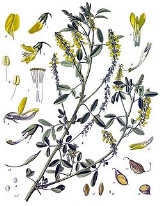
Melilotus officinalis
Encyclopedia
Melilotus officinalis, known as the yellow sweet clover, yellow melilot, ribbed melilot or common melilot is a species of legume native to Eurasia
and introduced in North America
, Africa
and Australia
.
. It has a bitter taste.
and has abundant seed production. In some areas it is an invasive species
. Common places where it can be found include prairies, abandoned fields, roadsides, and railroad ballasts. It does not tolerate dense shade.
despite its toxic properties when moldy. It is considered an excellent green manure
. Also, sweet clover is a major source of nectar
for domestic honey bee
s. Flowers and seeds can be used as flavoring.
In the chemical industry, dicoumarol is extracted from the plant to produce rodenticides.
Eurasia
Eurasia is a continent or supercontinent comprising the traditional continents of Europe and Asia ; covering about 52,990,000 km2 or about 10.6% of the Earth's surface located primarily in the eastern and northern hemispheres...
and introduced in North America
North America
North America is a continent wholly within the Northern Hemisphere and almost wholly within the Western Hemisphere. It is also considered a northern subcontinent of the Americas...
, Africa
Africa
Africa is the world's second largest and second most populous continent, after Asia. At about 30.2 million km² including adjacent islands, it covers 6% of the Earth's total surface area and 20.4% of the total land area...
and Australia
Australia
Australia , officially the Commonwealth of Australia, is a country in the Southern Hemisphere comprising the mainland of the Australian continent, the island of Tasmania, and numerous smaller islands in the Indian and Pacific Oceans. It is the world's sixth-largest country by total area...
.
Description
This biennial plant is 2 to 4 feet high at maturity and blooms in spring and summer. Flowers are yellow. Its characteristic sweet odor, intensified by drying, is derived from coumarinCoumarin
Coumarin is a fragrant chemical compound in the benzopyrone chemical class, found in many plants, notably in high concentration in the tonka bean , vanilla grass , sweet woodruff , mullein , sweet grass , cassia cinnamon and sweet clover...
. It has a bitter taste.
Ecology
This plant is very common as it can adapt itself to various soils (but especially likes alkaline soils) and climates. It is resistant to droughtDrought
A drought is an extended period of months or years when a region notes a deficiency in its water supply. Generally, this occurs when a region receives consistently below average precipitation. It can have a substantial impact on the ecosystem and agriculture of the affected region...
and has abundant seed production. In some areas it is an invasive species
Invasive species
"Invasive species", or invasive exotics, is a nomenclature term and categorization phrase used for flora and fauna, and for specific restoration-preservation processes in native habitats, with several definitions....
. Common places where it can be found include prairies, abandoned fields, roadsides, and railroad ballasts. It does not tolerate dense shade.
Toxicology
Sweet clover contains coumarin that converts to dicoumarol (a powerful anticoagulant toxin) when the plant becomes moldy. This can lead to bleeding diseases (internal hemorrhaging) and death in cattle. Consequently, hay containing the plant must be properly dried and cured, especially in wet environments.Uses
This plant is mainly used for agricultural purposes. It is grown as hayHay
Hay is grass, legumes or other herbaceous plants that have been cut, dried, and stored for use as animal fodder, particularly for grazing livestock such as cattle, horses, goats, and sheep. Hay is also fed to pets such as rabbits and guinea pigs...
despite its toxic properties when moldy. It is considered an excellent green manure
Green manure
In agriculture, a green manure is a type of cover crop grown primarily to add nutrients and organic matter to the soil. Typically, a green manure crop is grown for a specific period of time , and then plowed under and incorporated into the soil while green or shortly after flowering...
. Also, sweet clover is a major source of nectar
Northern Nectar Sources for Honeybees
The nectar source in a given area depends on the type of vegetation present and the length of their bloom period. What type of vegetation will grow in an area depends on soil texture, soil pH, soil drainage, daily maximum and minimum temperatures, precipitation, extreme minimum winter temperature,...
for domestic honey bee
Honey bee
Honey bees are a subset of bees in the genus Apis, primarily distinguished by the production and storage of honey and the construction of perennial, colonial nests out of wax. Honey bees are the only extant members of the tribe Apini, all in the genus Apis...
s. Flowers and seeds can be used as flavoring.
In the chemical industry, dicoumarol is extracted from the plant to produce rodenticides.

